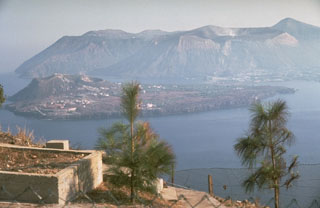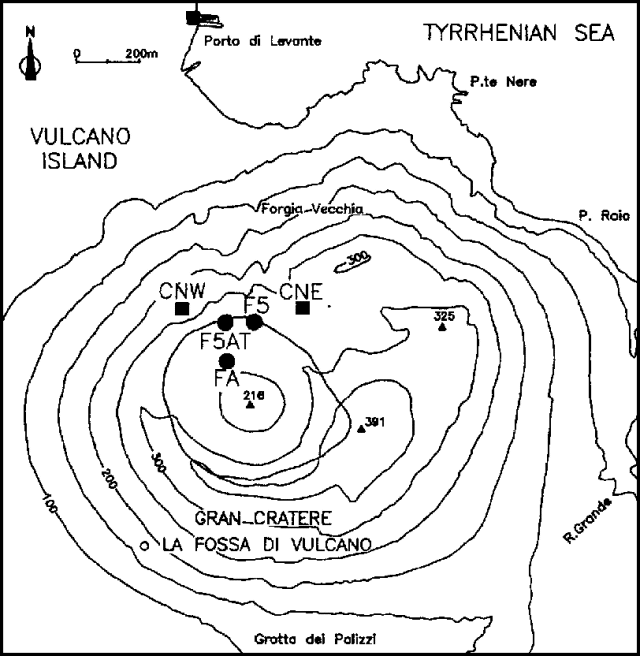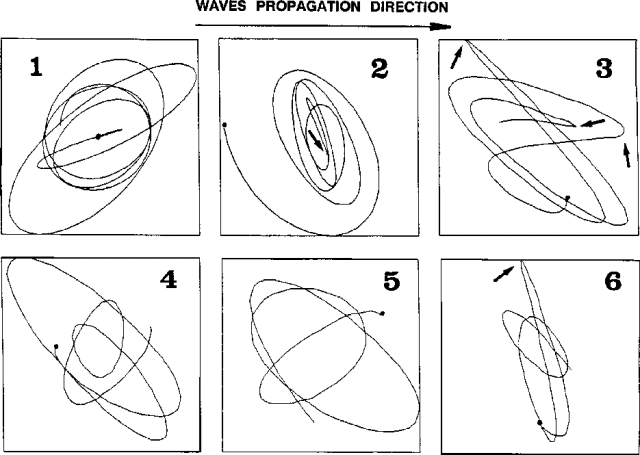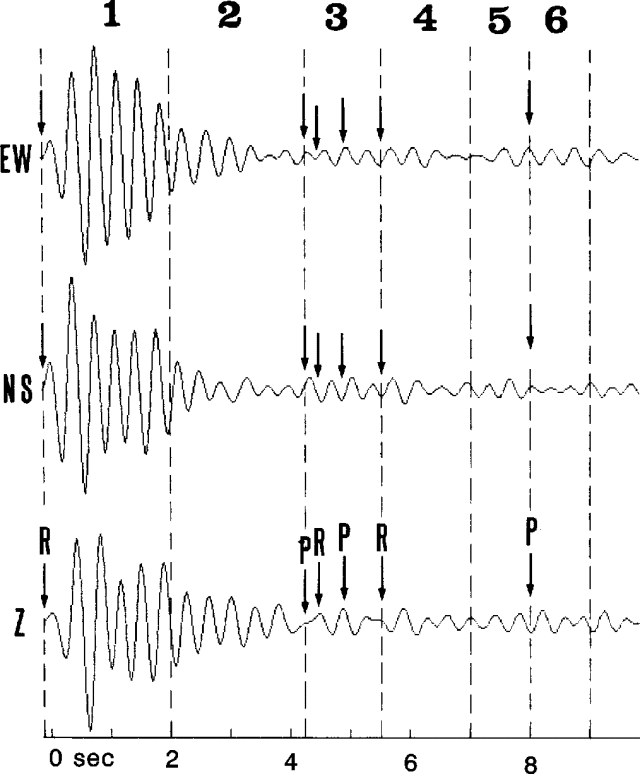Report on Vulcano (Italy) — August 1990
Bulletin of the Global Volcanism Network, vol. 15, no. 8 (August 1990)
Managing Editor: Lindsay McClelland.
Vulcano (Italy) High fumarole temperatures and geochemical changes; seismicity suggests complex fumarolic system
Please cite this report as:
Global Volcanism Program, 1990. Report on Vulcano (Italy) (McClelland, L., ed.). Bulletin of the Global Volcanism Network, 15:8. Smithsonian Institution. https://doi.org/10.5479/si.GVP.BGVN199008-211050
Vulcano
Italy
38.404°N, 14.962°E; summit elev. 500 m
All times are local (unless otherwise noted)
"OV geologists visited Vulcano island in recent months. Temperatures of the sampled crater fumaroles F5, F5AT, and FA (figure 9) were 300°, 420°, and 537°C respectively on 18 August. During two night inspections inside the crater, bright glow was discovered at all fumaroles up to 530°C and blue flames were discovered at some points in the fumarolic field, probably revealing burning of molten sulfur.
Geochemistry. "Several chemical variations have been observed since April 1990 in fluids sampled at F5 fumaroles. A sharp decrease in H2O content similar to that recorded in 1988 (see figure 7) has occurred. Consequently, CO2, SO2, N2, HCl, and HF increased in content. At the same time, the S/C ratio significantly decreased. Chemical variations seemed to follow the trend recorded in 1988. These data agree with an unpublished model by Tedesco et al. of possible mixing between shallow and deep fluids, continuously occurring in different proportions before gas escapes from fumarolic vents.
Geophysics. "A microseismicity study of Vulcano crater by the OV in the summer of 1988 revealed the presence of Rayleigh and Rayleigh-like waves with a prograde rotation (15:03). The analyzed earthquakes were low-frequency events, with energy up to 1012 ergs, showing phases not clearly identifiable on seismograms. Most scientists believe them to be related to gas flow in fumarolic conduits (Blot, 1971; Latter, 1971). Particle motion analysis revealed retrograde and prograde elliptical orbit phases that followed one another during such earthquakes (figures 10 and 11). This physical phenomenology was interpreted as due to propagation and reflection of tube waves in a fluid-filled conduit (White, 1983; Toksoz and Stewart, 1984; Hardage, 1985). According to such a model, the successive rotation inversions of particle motion would be generated from alternating downgoing and upgoing tube waves. The non-correlativity of phase arrivals among the seismic network stations suggested complex circulations discriminated by tube heights, because of the presence of several reflecting points (in fact seismographs operated at different altitudes on Vulcano island).
"In May 1990, a survey was carried out to verify the possible presence of correlativity and synchrony of phase arrivals at two seismic stations placed at the same altitude on the top of the crater. Stations were installed at ~90° from each other with respect to the crater axes (figure 9). Notwithstanding the low activity level during the 2-week recording period, the few events analyzed show the same phenomenology observed on 1988 records. Unfortunately, the expected correlativity was absent. The negative result, not invalidating the proposed model, suggested a complex geometry of the tube-like source structure, such as non-vertical orientation."
References. Blot, C., 1971, Etude sismologique de Vulcano: Cahiers ORSTOM serie Géophysique, no. 11.
Hardage, B.A., 1985, Vertical seismic profiling, Part A: Principles, in Helbig, K., and Treitel, S., eds., Handbook of Geophysical Exploration: Geophysical Press, p. 71-95.
Latter, J.K., 1971, Near Surface seismicity of Vulcano, Aeolian Islands, Sicily: BV, v. 35, p. 117-126.
Toksoz, M.N., and Stewart, R.R., eds., 1984, Vertical seismic profiling, Part B: Advanced Concepts, in Helbig, K., and Treitel S., eds., Handbook of Geophysical Exploration: Geophysical Press, p. 256-313.
White, J.E., 1983, Underground sound: application of seismic waves: Elsevier, New York, p. 139-191.
Geological Summary. The word volcano is derived from Vulcano stratovolcano in Italy's Aeolian Islands. Vulcano was constructed during six stages over the past 136,000 years. Two overlapping calderas, the 2.5-km-wide Caldera del Piano on the SE and the 4-km-wide Caldera della Fossa on the NW, were formed at about 100,000 and 24,000-15,000 years ago, respectively, and volcanism has migrated north over time. La Fossa cone, active throughout the Holocene and the location of most historical eruptions, occupies the 3-km-wide Caldera della Fossa at the NW end of the elongated 3 x 7 km island. The Vulcanello lava platform is a low, roughly circular peninsula on the northern tip of Vulcano that was formed as an island beginning more than 2,000 years ago and was connected to the main island in about 1550 CE. Vulcanello is capped by three pyroclastic cones and was active intermittently until the 16th century. Explosive activity took place at the Fossa cone from 1898 to 1900.
Information Contacts: D. Tedesco, S. Vulcano, and G. Luongo, OV.




